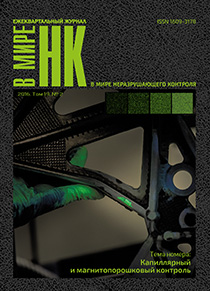Introduction. Accurate grading of ferromagnetic steels, especially under production conditions, may be considered as a serious problem. Chemical analysis, which is mostly used for this purpose, gives just quantitative parameters of alloying additions (not the steel grade); on the other hand, a certain amount of specimen material is needed to be analyzed, so it cannot be regarded as non-destructive. That is why some attempts have been made to use non-destructive techniques, particularly a magnitude-phase eddy current method, for steel grading. Method. The article offers eddy current method for permeability measuring at any frequency with subsequent use of the measurement results for computerized steel grading. The method includes measuring of specimen signal amplitude and phase and comparison the obtained results with theoretically calculated values of the same parameters. The experimental equipment and electric circuit with an eddy current transducer of superposed type is described. For the transition from measured electrical parameters to the magnetic characteristics of metals it is used the mathematical model based on the well-known solution of the corresponding electrodynamics problem. The permeability is defined by solving Maxwell equations with functional minimization according to the Nelder-Mied method. Results. The defined permeability also maintains the information of time that is necessary for specimen magnetizing. That makes it possible to complete non-destructive testing with valuable informative parameter that essentially increases a possibility of identification of material magnetic properties. The examples of steel grades identification together with corresponding illustrations are given. Conclusion. In some cases the method may be used for definition or at least for more precise definition of the different steel grades.
magnitude-phase method, eddy current transducer, frequency, permeability, mathematical model, steel grade
1. Sandovskiy V. A. Magnetic Properties of Ferromagnetic Cores in a Low-Frequency Uniform Field. Russian J. Nondestructive Testing. 2005, vol. 41, no.10, pp. 666-673.
2. Sandovskiy V. A., Dyakin V. V., Dudarev M. S. Hodographs of Magnetic Permeability of Cylindrical Rods in Homogeneous AC Magnetic Field. Russian J. Nondestructive Testing. 2002, vol. 38, no.1, pp. 40-48.
3. Sandovskiy V. A., Dyakin V. V., Dudarev M. S. Defektoskopiya [Flaw Detection]. 1999, no. 4, pp. 47-55 (in Russ.).
4. Sandovskiy V. A., Dyakin V. V., Dudarev M. S. Defektoskopiya [Flaw Detection]. 1997, no. 1, pp. 63-66 (in Russ.).
5. Dyakin V. V., Sandovskiy V. A. Zadachi elektrodinamiki v nerazrushayushchem kontrole [Problem of electrodynamics in non-destructive testing]. Ekaterinburg, UrO RAN, 2007, 390 p. (in Russ.).
6. Levit M. G. Programmnoe obespechenie dlya resheniya zadach chislennogo analiza na SM EVM [Software for solving problems of numerical analysis with the SM computer]. Kishinev, Shtiintsa, 1991, 237 p. (in Russ.).
7. Vonsovskiy S. V. Magnetizm [Magnetics]. - Moscow, Nauka, 1971, 1032 p. (in Russ.).
8. Kadochnikov A. I. Fizika metallov i metallovedenie [The Physics of Metals and Metallography]. 1997, v. 83, no. 1, pp. 506-510 (in Russ.).





